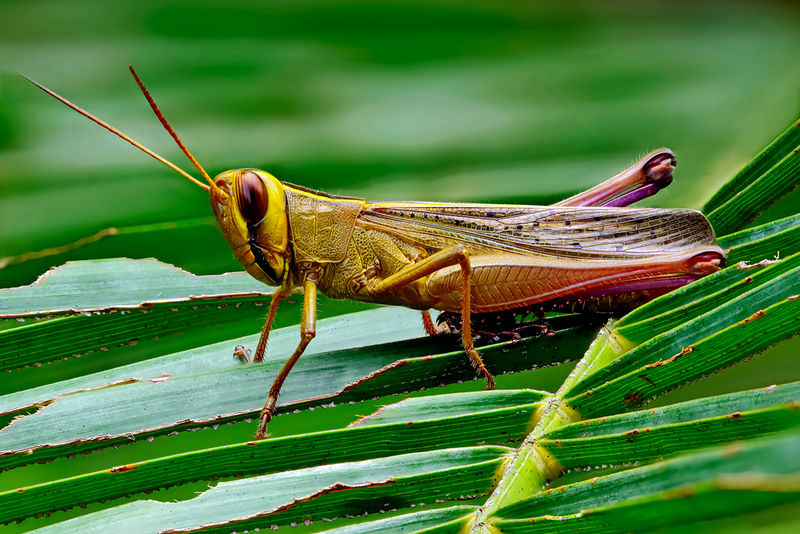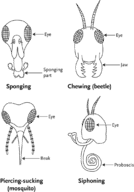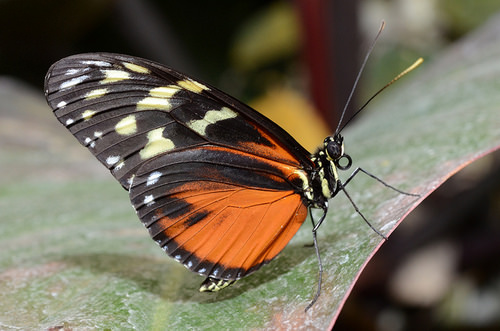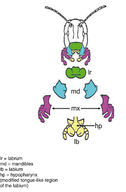15.37 昆虫结构和功能 -- -- 高级
章节大纲
-
Is the structure-function relationship obvious?
::结构-功能关系是否明显?Yes, especially in this close-up of a grasshopper. The structure of this insect is apparent: there are distinct head, thorax, and abdomen regions. The enlarged hind femora, with powerful , stand out. Grasshoppers and other jumping share these enlarged muscles.
::是的,特别是在这种近距离的蝗虫中。这种昆虫的结构是显而易见的:有不同的头部、胸部和腹部区域。 扩大的后后方,有强大的力量,非常突出。 蝗虫和其他跳跃者分享了这些扩大的肌肉。Structure and Function in Insects
::昆虫中的结构和功能The basic structures of insects are similar to those of all . They have a complete digestive tract, an open circulatory system , and a . There are some features that they share only with arthropods such as a tracheal . There are still other features that are truly unique to insects. The most obvious of these are the wings . Insects are the only invertebrates that are capable of flight . In this section we will examine the details of insect structure and function, including a look at the insect wing and how it has contributed to the success of this organism .
::昆虫的基本结构与所有昆虫的基本结构相似。 它们有一个完整的消化道,一个开放的循环系统,以及一个。 它们只有节肢动物(例如气管)才具有某些共同特征。 还有一些昆虫真正独有的其他特征。 其中最明显的是翅膀。 昆虫是唯一能够飞行的无脊椎动物。 在本节中, 我们将研究昆虫结构和功能的细节, 包括研究昆虫翅膀, 以及它如何为这种生物的成功做出贡献。Feeding, Digestion, and Excretion
::进食、消化和排泄There is a variety of types of feeding among insects. There are carnivores , herbivores , scavengers , and parasites . One parasitic insect that you are probably very familiar with is the mosquito. Mosquitoes feed on mammalian . The different insect diets require different types of feeding appendages , or mouthparts. The mouthparts may be modified to obtain nutrients in several different ways:
::昆虫之间有多种不同的喂养方式,有食肉动物、食草动物、拾荒者和寄生虫。一种寄生虫是蚊子,你可能非常熟悉。蚊子是蚊子。蚊子以哺乳动物为食。不同的昆虫饮食需要不同种类的喂食配方,或嘴部。口部分可以有几种不同的方式修改,以获得养分:-
Chewing (grasshoppers and beetles).
:: -
Siphoning (butterflies and moths).
::西福宁(和飞蛾) -
Piercing and sucking (mosquitoes).
::偷吃和吸食(吸食和吸食)。 -
Sponging
(flies).
::海绵(苍蝇)
Insects have three sets of mouthparts that include one pair of mandibles and two pairs of maxillae. You may recall from a previous lesson that mandibles are generally used for biting and chewing food , while maxillae are used for manipulating and swallowing food. Many adaptations of these three pairs of mouthparts are found in the insect class to accommodate the different ways of obtaining nutrients listed above. For example, in chewing insects, such as dragonflies and beetles, the mandibles are often quite large and protrude out from the head. In carnivorous chewing insects, the mandibles may be modified to function as weapons, while herbivorous chewing insects generally have flattened mandibles suitable for grinding plant tissue . An example of a of beetle with mandibles modified as hunting weapons is shown in Figure .
::昆虫有三组口袋,包括一对护甲和两对护目动物。从以前的教训中,可以回顾道具通常用于咬咬和咀嚼食物,而麦花则用于操纵和吞食食物。昆虫类中发现这三对口袋有许多调整,以适应获得上述营养的不同方式。例如,在咀嚼昆虫,如龙毛虫和甲虫,其外脏往往很大,而且从头部流出。在食肉类咀嚼昆虫中,肉类可改装为武器功能,而食草类咀嚼昆虫通常有适合研磨植物组织的扁形甲。图中展示了甲虫和甲壳虫作为狩猎武器改型动物的例子。A predatory beetle with mandibles modified for defense and attack. In insects such as this one, the mandibles are strictly used as weapons and no longer function in feeding.
::在这种昆虫中,甲壳虫被严格用作武器,不再用于喂食。Mouthpart Specialization in Insects. The mouthparts of insects are adapted for different food sources. How do you think the different mouthparts evolved?
::昆虫的口腔专门化。昆虫的口部适应不同的食物来源。 你认为不同的口部是如何进化的?In contrast, siphoning insects, such as moths or butterflies, do not have much use for a chewing appendage, and the mandible is often reduced or even lost in these species. Instead, they have a long tubular proboscis that extends out from the mouth, as shown in Figure and Figure . This allows the insect to suck nectar from flowers .
::相反,吸食昆虫,如飞蛾或蝴蝶等,对于咀嚼的附着物没有多大用处,而且这些物种的栖息物往往减少甚至丢失。 相反,它们有一个长长的管状胸骨,从嘴部延伸出来,如图和图所示。 这使得昆虫能够吸食花蜜。A siphoning insect with a long coiled proboscis used for feeding. Insects that feed by piercing and sucking nutrients from their prey have a modified proboscis with a sharp end called a stylet used for penetrating the skin of prey.
::用于喂食的吸食昆虫,其长长的卷状蛋白质,通过穿孔和吸食猎物养分喂养的昆虫,有改良的蛋白质,其尖端叫做刺穿猎物皮肤的风格。Piercing and sucking insects, such as mosquitoes, also have a modified mouthpart called a stylet that allows them to both pierce the skin of their prey and then suck food from the organism. Two other insect mouthparts are called the labium and labrum. They essentially form the base (or floor) and the top (or roof) of the mouth respectively. In sponging insects, such as flies, digestive are secreted onto the solid food source to allow it become somewhat of a liquid. The insect then uses a modified labium to “sponge up” and deliver the food to the esophagus . Sponging insects often have reduced mandibles. The relative positions of the insect mouthparts are shown in Figure .
::蚊子等穿孔和吸吸昆虫也有一个改口口部分,称为“样式”,允许它们穿透猎物的皮肤,然后从有机体中吸食食物,另外两个昆虫口部分称为“”和“”,它们基本上分别构成嘴底(或地板)和顶(或屋顶),在象苍蝇这样的海绵昆虫中,消化剂被隐藏在固体食物源中,以便使其变成某种液体。昆虫然后使用经修改的将食物送到食道。海绵昆虫往往减少了人性。昆虫口部分的相对位置在图中显示。The mouthparts of a grasshopper. The top diagram represents the head of a typical grasshopper. Each mouthpart is shown separately below with labels as follows: lr = labrum, md = mandibles, mx = maxillae, lb = labium, hp = hypopharynx (modified tongue-like region of the labium).
::的嘴部。 上图代表典型的头。 每个嘴部分别显示如下标签: lr = libraum, md = mandibles, mx = Maxillae, lb = lib = lium, hp = poidpharynx( 的舌状区域) 。Insects have a complete digestive tract that is divided into three main regions that follow the pharynx and esophagus: a foregut, midgut, and hindgut. The forgut is basically a crop-like region that functions to grind and pulverize ingested food particles. The midgut is where most of the food is digested with enzymes and nutrients are absorbed. Most insects use Malphigian tubules as excretory organs to regulate salt balance in their bodies. As you learned in the Arthropods: Structure and Function concept, Malphigian tubules do not exit the body directly but instead empty into the hindgut of the digestive tract. As a result, the hindgut of insects also carries out some excretory functions. In the hindgut, and salts may be absorbed from both the digested material and the urine intake from the Malphigian tubules in order to regulate osmotic balance in the organism and concentrate waste material for excretion . Osmotic balance is the control of salt concentrations in tissues and fluids of the body, and it is critical that these levels are kept within a certain range in order for to function properly. Figure shows the internal anatomy of a typical insect. The is shown in green, and the Malphigian tubules are shown in yellow.
::昆虫有完整的消化道, 并分为三个主要区域, 沿着pharynx 和 esopagus 之后的三块主要区域: 一个前身、 中间角、 和 hindgut 。 叉形基本上是一个类似作物的区域, 其功能是研磨和粉碎食食用颗粒。 中间国是大部分食物被酶和营养吸收的地方。 大部分昆虫使用麦菲吉亚管状管作为排泄器官来调节身体的盐平衡。 正如你在Arthropods : 结构和功能概念中学到的, 马尔菲吉亚管不是直接离开身体, 而是空进入消化道的顶部。 结果, 昆虫的顶部也具有某种外科功能。 在中, 盐可以被消化物质吸收, 和马菲吉亚管吸收的尿液, 以调节生物体和浓缩物料的平衡。 骨质平衡不是直接离开身体, 而骨质平衡是典型的浓度范围 。 在图中, 盐质组织中, 显示的精质和体中, 显示的精质的精度是一定 。 。 在图中, 的精质中, 的精质中, 显示的精质的精质的精度在图中, 。The internal anatomy of insects. The main body regions are labeled: A - Head, B - Thorax, C - Abdomen. Various organs and body parts are labeled as follows: 1. antenna, 2. ocelli (lower), 3. ocelli (upper), 4. compound eye, 5. brain (cerebral ganglia), 6. prothorax, 7. dorsal artery, 8. tracheal tubes (trunk with spiracle), 9. mesothorax, 10. metathorax, 11. first wing, 12. second wing, 13. mid-gut (stomach), 14. heart, 15. ovary, 16. hind-gut (intestine, rectum & anus), 17. anus, 18. vagina, 19. nerve cord, 20. Malpighian tubes, 21-26 segments of the leg, 27. fore-gut (crop, gizzard), 28. thoracic ganglion, 29. coxa (base of the legs), 30. salivary gland, 31. subesophageal ganglion, 32. mouthparts. Notice that most of these systems are similar to those of a typical arthropod, shown in lesson one. Major differences include Malphigian tubules, trachea, and wings.
::昆虫的内部解剖。主体区域标签如下:A - 头,B - 索拉克斯,C - 腹部。各种器官和身体部位标签如下: 1. 天线, 2. ocelli(低)、 3. ocelli(上)、 4. 复合眼、 5. 大脑( 冠状帮派)、 6. 胸腔, 7. 胸动脉、 8. 气管( 带刺) 、 9. 间歇曲轴、 10. 元体、 11. 第一翼、 12. 二翼、 13. 二翼、 13. 中螺旋( 直肠)、 14. 心脏、 15. 卵巢、 16. 后盖( 肠、 直肠和 肛门)、 17. 肛门、 18. 阴道、 19. 神经索、 20. 马拉皮琴管、 腿的21-26部分、 27. 尖形管( 子、 皮扎)、 28. 胸腺结裂、 29. 阴部、 29. 直角( 腿底部)、 3. 30 萨利藻、 31. 底部、 底部、 31. 结膜、 3. 口部 、 3. 表示这些系统与典型的区别、 等。Respiration and Circulation
::呼吸和流通The of insects serves a number of functions, including the transport of nutrients, salts, waste, and throughout the body. It also acts like a very primitive immune system to generate wound-healing clots and to attack cells of infectious organisms that have entered the body such as . Like other arthropods, insects have an open circulatory system in which the blood (called hemolymph ) spends most of its time in body cavities called hemocoels and only a small amount of time flowing through . Figure shows the insect circulatory system in red.
::昆虫具有多种功能,包括营养素、盐类、废物和整个身体的迁移,还像一种非常原始的免疫系统,产生愈合伤口的血块,攻击已经进入身体的传染性生物细胞,例如:像其他节肢动物一样,昆虫有一个开阔的循环系统,血液(称为hemolymph)大部分时间花在被称为肝脏的体腔中,只有一小部分时间流经。图显示昆虫循环系统的红色。One interesting feature of the insect circulatory system is that it does not contain oxygen-transporting molecules. Unlike most invertebrates (and vertebrates) that use respiratory organs to absorb oxygen from their environments and deliver it to the circulatory system for dispersal throughout the body, insects (and some other arthropods) do not transport oxygen via the circulatory system. Instead, insects have a highly efficient respiratory system that is composed of trachea . The tracheal system is composed of tubules that take in air from the environment through spiracles and carry it throughout the organism to bring oxygen directly to various tissues. Spiracles are small openings on the outside of the body. The tracheal system is labeled with the number “8” in Figure . Figure shows the spiracles of a caterpillar.
::昆虫循环系统的一个有趣的特征是它不包含氧传导分子。与大多数使用呼吸器官从环境中吸收氧气并将其送到循环系统以分散整个身体的无脊椎动物(和脊椎动物)不同,昆虫(和其他一些节肢动物)不通过循环系统输送氧气。相反,昆虫有一个高效的呼吸系统,由气管组成。气相系统由气相系统组成,由气相系统组成,由气相组成,从空气中取自空气中的管状体组成,通过触角将管带入整个生物体,直接将氧气带入各种组织。骨部是身体外的小开口。气相系统与图中的“8”号标有标签。图图显示了毛虫的发孔。The spiracles of a caterpillar. Spiracles are small openings on the outside of an insect's body that take air into the tracheal respiratory system.
::毛毛虫的螺丝。螺丝是昆虫身体外的小孔,把空气带入气管呼吸系统。Nervous System
::神经系统Insects, like other arthropods that you have learned about in this chapter, have a central nervous system with a brain located in the head region and a pair of ventral nerve cords that run along the bottom interior of the body. Along the nerve cord there are pairs of ganglia located in each segment that function to innervate organs and tissues within that segment.
::昆虫与本章中所了解的其他节肢动物一样,有一个中枢神经系统,其大脑位于头部区域,还有一对沿着身体底部内部运行的直肠神经线。在神经脊髓上,每个部分都有两对帮派,它们起到内肠器官和组织的作用。The sensory capabilities of insects include touch, sound, sight , and smell (called chemoreception). A few insects, such as bees and butterflies, actually have color . Most of these capabilities from sensory organs found in the head region. You have already learned that arthropods may have simple and compound eyes for sensing light and forming images as well as bristles on the surface of their bodies for sensing touch. The simple eyes, called ocelli , and compound eyes of an insect are shown above in Figure . You have also learned that most arthropods, with the exception of chelicerates, have antennae for sensory perception. What exactly do they sense? The answer is that the antennae can sense a number of different environmental stimuli . They often have chemoreceptors that are capable of detecting, or “smelling,” certain molecules present in the air around them. Some of these receptors can also detect, or “ taste ,” the molecules of liquid or solid substances. Figure shows the head region of various insects, highlighting the variations in insect antennae.
::昆虫的感官能力包括触摸、听觉、视力和嗅觉(称为切莫感知) 。 少数昆虫,例如蜜蜂和蝴蝶,实际上都有颜色 。 这些能力大多来自头部区域的感官器官 。 您已经知道, 节肢动物在感测光线和在身体表面形成图像和晶体时, 可能有简单和复合的眼线, 以感知光和形成图象。 上面的图中显示了被称为八眼的简单眼睛和昆虫的复合眼睛。 您还了解到, 多数节肢动物, 除虱子外, 都有触觉感知的天线。 它们究竟能感知到什么? 答案是, 天线能感知到许多不同的环境象素。 它们通常有能够检测, 或“ 熔炼” 空气周围的某些分子的乳色感官。 这些受体也能够检测, 或“ 塔特” 液体或固体物质的分子。 图中显示了各种昆虫的头区域, 突出昆虫天线的变化 。The antennae of various insects. Note the differences in length and shape between each pair of antennae.
::各种昆虫的天线。 注意每对天线之间的长度和形状差异 。In addition, some antennae have organs called Johnston’s organs that detect the position of the antennae and, in some cases, can detect sound vibrations. However, insects that can detect sound, such as grasshoppers, moths, and butterflies, generally use tympanal organs located on various parts of the body, depending on the species. The tympanal organs are made up of an eardrum-like membrane.
::此外,有些天线的器官叫做约翰斯顿(Johnston)的器官,它们能检测天线的位置,有时还能检测声音振动。 然而,能够检测声音的昆虫,如、飞蛾和蝴蝶,通常使用位于身体不同部位(视物种而定)的突触器官。 突触器官由耳膜一样的膜组成。The ability to sense many aspects of their environment is a fundamental component of the ability of some insects to have fairly complex responses to or interactions with their environments. These will be discussed in the Insects: Behavior (Advanced) concept.
::能够感知其环境的许多方面是某些昆虫能够对环境作出相当复杂的反应或与其环境相互作用的基本组成部分,将在《昆虫:行为(高级)概念》中加以讨论。Summary
::摘要-
Insects are the only invertebrates that are capable of flight.
::昆虫是唯一能够飞行的无脊椎动物。 -
Insects have three sets of mouthparts that include one pair of mandibles and two pairs of maxillae.
::昆虫有三组嘴部 包括一对甲壳虫 和两对甲状腺虫 -
Depending on how an insect feeds, the mouthparts become adapted to specific functions.
::视昆虫的喂养方式而定,口部分适应特定功能。 -
Insects have a complete digestive tract that is divided into three main regions that follow the pharynx and esophagus: a foregut, midgut, and hindgut.
::昆虫有完全的消化道,分为三个主要区域,沿Pharynx和Esophagus地区:一个前额、中位和后位。 -
Insects, like other arthropods, have a central nervous system with a brain located in the head region and a pair of ventral nerve cords that run along the bottom interior of the body.
::像其他节肢动物一样,昆虫有一个中枢神经系统,大脑位于头部区域,还有一对沿着身体底部内部运行的心神经索。 -
Most arthropods, with the exception of chelicerates, have antennae for sensory perception.
::大多数节肢动物,除切开氏剂外,都有触觉感知天线。
Review
::回顾-
Which mouthparts are present in almost all insects?
::几乎所有昆虫中都有哪个口部? -
Describe how insects have adapted their mouthparts for different functions.
::说明昆虫如何根据不同功能调整其嘴部。 -
What is the function of the forgut, midgut, and hindgut?
::福古特、中古特和后古特的功能是什么? -
How does the respiratory system of insects differ from most animals?
::昆虫的呼吸系统与大多数动物有何不同? -
What kind of sensory input do antennae provide for insects?
::天线为昆虫提供何种感官输入?
-
Chewing (grasshoppers and beetles).







